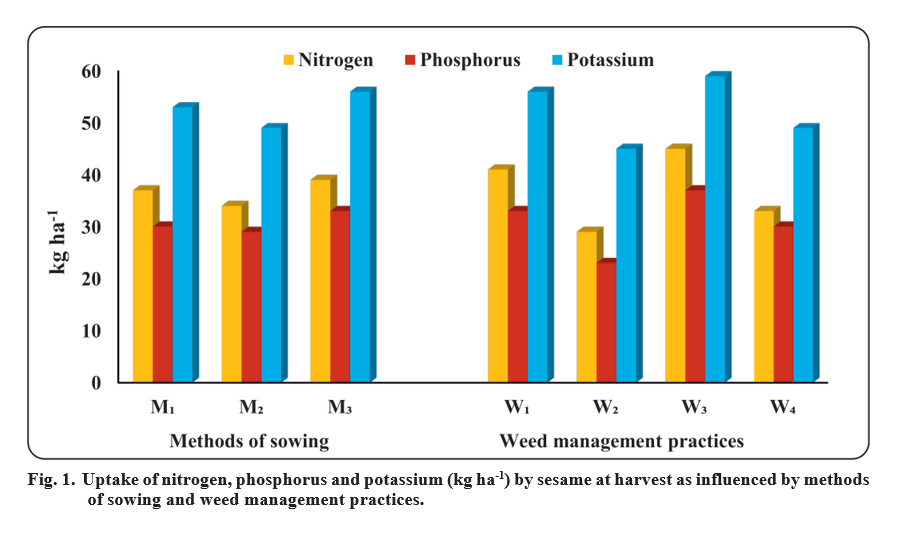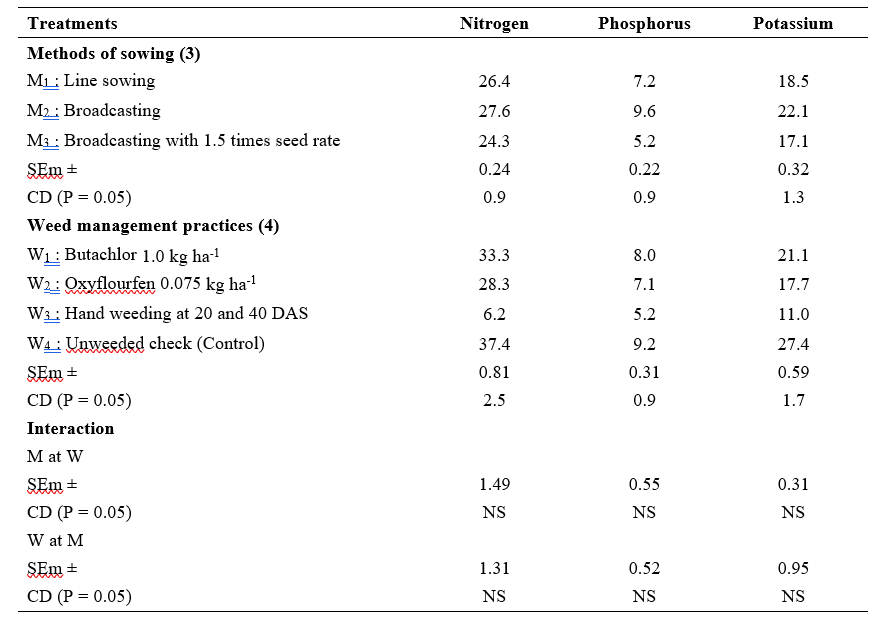Nutrient Uptake as Influenced by Methods of Sowing and Weed Management Practices in Summer Sesame (Sesamum Indicum L.)
0 Views
BHAVANI*, G. KRISHNA REDDY, P. MAHESWARA REDDY, LAVANYA KUMARI AND G. KARUNA SAGAR
Department of Agronomy, S.V. Agricultural College, ANGRAU, Tirupati-517 502.
ABSTRACT
A field experiment was conducted during summer, 2022 at S.V. Agricultural College Farm, Tirupati. The experiment was laid out in split-plot design and replicated thrice. The treatments consisted of three methods of sowing (3) viz., line sowing (M1), broadcasting (M2) and broadcasting with higher seed rate (M3) assigned to main plots and four weed management practices (4) viz., pre-emergence application of butachlor 1.0 kg ha-1 (W1), pre-emergence application of oxyfluorfen 0.075 kg ha-1 (W2), hand weeding twice at 20 and 40 DAS (W3) and unweeded check (Control) (W4) allotted to sub plots. Among the methods of sowing highest uptake of N, P and K by sesame was with broadcasting higher seed rate. Hand weeding recorded significantly higher N, P and K uptake by sesame crop compared to other three weed management practices. Lower nutrient uptake of N, P and K by crop was with unweeded check.
KEYWORDS: Sesame, Methods of sowing, Pre-emergence herbicides, Nutrient uptake.
INTRODUCTION
Sesame (Sesamum indicum L.) is one of the foremost conventional oilseed crop cultivated in tropical, subtropical, Asian and African nations. It is one of the important oilseed crop in Indian agriculture, commonly known as til. Sesame oil contains the significant amount of polyunsaturated fatty acids, such as oleic and linolenic acids ranging from 30.9 to 52.5 per cent. India ranks first both in area and production of sesame in the world and the largest (40%) sesame exporter in the world. In India, sesame is cultivated in 16.22 lakh hectares, 6.57 lakh tonnes of production with a productivity 405 kg ha-1. In Andhra Pradesh, sesame is grown in 39,000 hectares of area with 13,380 tonnes of production and productivity of about 343 kg ha-1 during 2019-2020 (www.indiastat. com). In most of the areas sesame crop is heavily infested by weeds and thereby resulting in heavy yield loss ranging from 16 to 68 per cent. The period from 15-30 days after sowing is the most critical period of crop-weed competition in sesame. Therefore, weed management is essential with pre-emergence herbicides in sesame to minimize the yield losses caused by weeds under different methods of sowing.
MATERIAL AND METHODS
The field experiment was conducted at S.V. Agricultural College, Tirupati campus of Acharya N.G. Ranga Agricultural University, Andhra Pradesh during summer, 2022. The soil of experimental field was sandy loam in texture, neutral in reaction, low in organic carbon (0.48%) available nitrogen (150 kg ha-1), high in available phosphorus (77 kg ha-1) and mediuin in available potassium (221 kg ha-1). The experiment was laid out in split-plot design and replicated thrice. The treatments consisted of three methods of sowing (3) viz., line sowing (M1), broadcasting (M2) and broadcasting with 1.5 times seed rate (M3) assigned to main plots and four weed management practices (4) viz., pre-emergence application of butachlor 1.0 kg ha-1 (W1), pre-emergence application of oxyfluorfen 0.075 kg ha-1 (W2), hand weeding at 20 and 40 DAS (W3) and unweeded check (Control) (W4) allotted to sub plots. In line sowing 30 cm x 15 cm spacing with a seed rate of 4 kg ha-1, broadcasting with a seed rate of 5 kg ha-1 and broadcasting with 1.5 times seed rate with a seed rate of 7.5 kg ha-1. The variety sarada (YLM-66) was sown on 19th of January and recommended dose of the fertilizer applied was 40-20-20 N-P2O5-K2O kg ha-1. Composite plant samples of crop as well as weeds from all the plots were collected at harvest and these samples were dried, ground into fine powder and used for estimation of N, P and K by using standard procedures outlined by Jackson (1973). The uptake of nitrogen, phosphorus and potassium at harvest by the crop and its associated weeds were calculated by multiplying the respective nutrient content with corresponding dry weights and expressed as kg ha-1. All the other recommended practices were also adopted as per the crop requirement.
Table 1. Uptake of nitrogen, phosphorus and potassium (kg ha-1) by sesame at harvest as influenced by methods of sowing and weed management practices

RESULTS AND DISCUSSION
The weed flora associated in the experimental field were Cyperus rotundus (40.0%), Commelina benghalensis (10.0%), Cleome viscosa (8.0%), Boerhavia diffusa (5.0%), Phyllanthus niruri (5.0%), Dactyloctenium aegyptium (5.0%) and Digitaria sanguinalis (4.0%). Nutrient uptake by sesame crop differed significantly due to methods of sowing and weed management practices. Interaction between these two practices was not statistically measurable. Among the methods of sowing, the highest uptake of N, P and K by sesame was with broadcasting higher seed rate due to lower weed infestation. Similar results have been reported by Rajpurohit et al. (2017). Hand weeding recorded significantly higher N, P and K uptake by sesame crop compared to other three weed management practices. This might be due to higher dry matter accumulation and higher nutrient content in sesame crop. The nutrient uptake by crop and associated weeds follows an inverse relationship as evident in the present investigations.
Lower nutrient uptake of N, P and K by crop was with unweeded check due to low dry matter production and reduced nutrient uptake by the crop as a result of heavy weed competition. These results are in conformity with the results of Sahoo et al. (2017).
Nutrient uptake by weeds differed significantly due to methods of sowing and weed management practices. Interaction effect between these two factors was not statistically measurable. Among the methods of sowing, highest uptake of N, P and K by weeds was with broadcasting due to high weed population. The results are in line with the findings of (Umed et al., 2009). Among the weed management practices, highest uptake of N, P and K by weeds was with unweeded check, which was significantly higher than the rest of the weed management practices due to severe weed competition from weeds. In all the crops, highest uptake of N, P and K by weeds was with unweeded check as conformed by several researchers.


Table 2. Uptake of nitrogen, phosphorus and potassium (kg ha-1) by weeds in sesame at harvest as influenced by methods of sowing and weed management practices

With regard to methods of sowing, highest uptake of N, P and K by sesame crop was due to broadcasting using higher seed rate. Among the weed management practices tried, hand weeding recorded significantly higher N, P and K uptake by sesame. Regarding the weed uptake among the methods of sowing, higher N, P and K uptake by weeds was with broadcasting and highest uptake of N, P and K by weeds was with unweeded check among different weed management practices.
LITERATURE CITED
Jackson, M.L. 1973. Soil chemical analysis. Prentice Hall of India Pvt. Ltd.
Mahajan, H.S and Hirwe, N.A. 2014. Economical assessment of critical period for crop-weed competition in rainfed sesame (Sesamum indicum L.). International Journal of Agricultural Sciences. 10(1): 179-181.
Rajpurohit, D.S., Arvadia, L.K and Jangir, R. 2017. Growth and yield of summer sesamum (Sesamum indicum L.), dry weight of weeds and weed control efficiency as influenced by different row spacing and weed management under South Gujarat condition. International Journal of Current Microbiology and Applied Sciences. 6(8): 2493-2501.
Umed, A.S., Rahman, Ejaz A.O., Shereen, G and Tareen, A.Q. 2009. Effects of sowing method and seed rate on growth and yield of wheat (Triticum aestivum). World Journal of Agricultural Sciences. 5(2): 159- 162.
- Bio-Formulations for Plant Growth-Promoting Streptomyces SP.
- Brand Preference of Farmers for Maize Seed
- Issues That Consumer Experience Towards Online Food Delivery (Ofd) Services in Tirupati City
- Influence of High Density Planting on Yield Parameters of Super Early and Mid Early Varieties of Redgram (Cajanus Cajan (L.) Millsp.)
- Influence of Iron, Zinc and Supplemental N P K on Yield and Yield Attributes of Dry Direct Sown Rice
- Effect of Soil and Foliar Application of Nutrients on the Performance of Bold Seeded Groundnut (Arachis Hypogaea L.)

